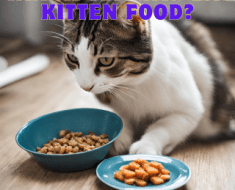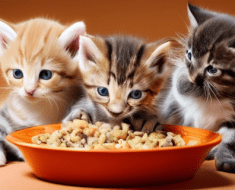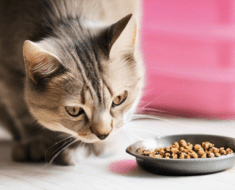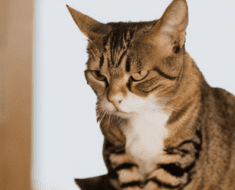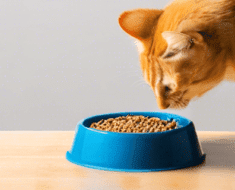When it comes to wet cat foods, not all options are created equal. So, we and This list expose the top 5 worst wet cat foods, shedding light on their nutritional shortcomings, low-quality ingredients, and feedback from concerned consumers. Ensuring your feline friend receives a nutritious and safe diet is a top priority for any cat owner. Unfortunately, not all cat food brands are created equal, with some posing serious issues related to quality, ingredients, and production practices that could harm your cat over time. In this updated guide for 2024, we’ll delve into the worst cat food brands to help you make informed decisions and prioritize your cat’s well-being.
Key Takeaways
- Beware of misleading labels on cat food brands.
- Familiarize yourself with ingredients and production issues affecting cat food quality.
- Learn how to read labels to identify healthier cat food options.
Identifying Poor-Quality Cat Food
When seeking the best cat food, understanding the distinction between high-quality and low-quality ingredients is crucial. Optimal cat food should be rich in animal protein (e.g., chicken, turkey) and animal fats, aligning with a cat’s carnivorous nature. It should also provide all essential vitamins and minerals in appropriate quantities.
Poor-quality cat food often includes cheap fillers with low-quality protein and additives like carrageenan that may jeopardize your cat’s health.
Meat By-Products
Examine cat food ingredient lists for named meat ingredients such as turkey liver, venison tripe, or chicken breast. Meat by-products, while nutritious, lack specificity regarding the source, potentially causing issues for cats with allergies. A 2015 study revealed that 20 of 53 wet cat foods with meat by-products did not list the specific meats on the label.
Meal Meals
Meat meals, often used in kibble, undergo heat treatment and have a protein quality of about 80% compared to raw meat. Understanding this distinction is crucial, especially for senior cats requiring higher protein intake to combat sarcopenia.
Grains and Legumes
Ingredients like corn, wheat, and soy should be limited or avoided due to potential digestive upset in cats. Legumes such as soy and peas may cause unpleasant gas symptoms.
Nutrition
Evaluate cat food based on protein, fat, and carbohydrate levels. Aim for at least 40% protein on a dry basis and less than 10% carbohydrate to align with a cat’s natural diet.
Preservatives
Opt for cat foods with natural preservatives like added vitamin E (tocopherol) and avoid chemical preservatives like BHA and ethoxyquin, which may pose health risks.
Other Undesirable Ingredients
Keep an eye out for undesirable ingredients in low-quality cat food, including corn gluten meal, wheat gluten, soybean meal, soy flour, carrageenan, and food starch (e.g., tapioca).
Statement of Nutritional Adequacy
Choose cat food labeled as “complete and balanced” for your cat’s specific life stage, ensuring it contains all essential vitamins and minerals.
Labeling
Pay attention to the descriptor term on cat food labels, as it indicates the percentage of the named ingredient in the product. Look for cat foods with a high percentage of named ingredients or at least 25% of named ingredients.
Top 5 Worst Wet Cat Foods Exposed!
Don’t Feed Your Cat These!
1. Mystery Morsels Mystery Meat Medley
- Nutritional Shortcomings:
– Lacks essential nutrients crucial for feline health.
– Unspecified meat sources raise questions about the quality and completeness of protein content.
- Low-Quality Ingredients:
– Vague labeling hides the true nature of ingredients.
– Filler ingredients like corn and by-products contribute to an unbalanced diet.
- Consumer Reviews:
– Numerous complaints about cats refusing to eat.
– Reports of digestive issues and adverse reactions.
2. Preservative-Loaded Poultry Pâté
- Nutritional Shortcomings:
– Excessive use of preservatives compromises nutritional integrity.
– Minimal meat content, leading to insufficient protein levels.
- Low-Quality Ingredients:
– High reliance on artificial flavors and colors.
– Generic poultry by-products instead of specific meat sources.
- Consumer Reviews:
– Concerns about the strong artificial odor.
– Cats displaying signs of lethargy and coat issues.
3. Fishy Fare Fish Bits in Gel
- Nutritional Shortcomings:
– Imbalance in omega-3 and omega-6 fatty acids.
– Lack of essential nutrients for cats with seafood allergies.
- Low-Quality Ingredients:
– Unspecified fish species, raising concerns about sourcing.
– Gel-based texture may hinder nutrient absorption.
- Consumer Reviews:
– Widespread reports of cats developing allergies.
– Complaints about the overwhelming fishy odor.
4. Generic Cat Cuisine with Mystery Gravy
- Nutritional Shortcomings:
– Insufficient vitamins and minerals for a complete diet.
– Lack of transparency regarding specific nutritional values.
- Low-Quality Ingredients:
– Mystery gravy raises doubts about ingredient quality.
– Generic meat by-products instead of named protein sources.
- Consumer Reviews:
– Cats exhibiting signs of weight loss and decreased energy.
– Consumer dissatisfaction with the lack of clarity on ingredients.
5. Carb-Loaded Cereal Casserole
Nutritional Shortcomings:
– High carbohydrate content, inappropriate for obligate carnivores.
– Insufficient meat content, leading to potential protein deficiencies.
Low-Quality Ingredients:
– Overreliance on grains like wheat and corn.
– Limited meat content, compromising overall nutritional value.
Consumer Reviews:
– Cats experiencing digestive issues and lethargy.
– Numerous reports of cats developing allergies and sensitivities.
Conclusion:
Choosing the right wet cat food is vital for your feline friend’s health. Steering clear of these top 5 worst wet cat foods can help ensure that your cat receives the nutrition it deserves without compromising on quality. Always prioritize transparency in labeling and seek products with high-quality, named meat sources to guarantee your cat’s well-being.
Frequently Asked Questions(FAQs) for Worst Wet Cat Food
What should I look for when choosing wet cat food?
A1: When choosing wet cat food, consider factors such as the ingredient list, artificial additives, carbohydrate content, meat sources, and overall nutrient profile. Look for products with high-quality, natural ingredients that meet your cat’s nutritional needs.
How can I identify artificial additives in wet cat food?
A2: Check the ingredient list for artificial colors, flavors, and preservatives. Avoid products with excessive use of these additives, as they may not be beneficial for your cat’s health. Opt for foods with minimal processing and natural ingredients.
Why is it important to check the carbohydrate content in wet cat food?
Cats are obligate carnivores, and their diet should primarily consist of meat. High carbohydrate content in cat food may not align with their nutritional needs and could lead to health issues. Choose wet cat foods with a lower carbohydrate content and higher levels of protein and fat.
What are common concerns with unidentified meat sources in cat food?
Vague terms like “meat by-products” or “animal by-products” may indicate lower quality or unspecified meat sources. It’s essential to choose wet cat foods that specify the type of meat used, ensuring that your cat gets high-quality and easily digestible proteins.
How can I ensure that the wet cat food meets my cat’s nutritional requirements?
Look for wet cat foods that meet the nutritional standards set by organizations like the Association of American Feed Control Officials (AAFCO). This ensures that the food provides a balanced nutrient profile, essential for your cat’s overall health and well-being.
